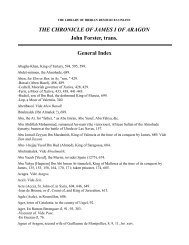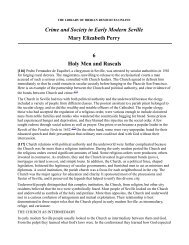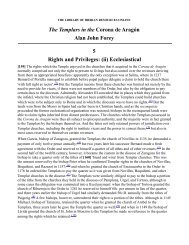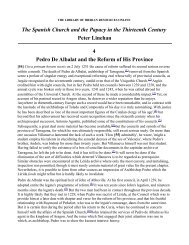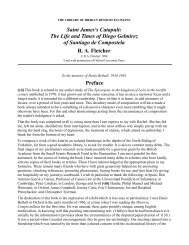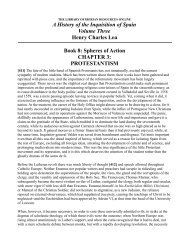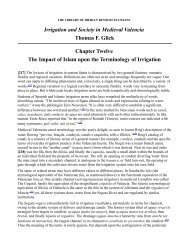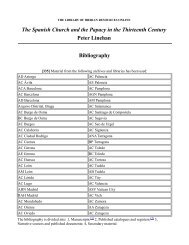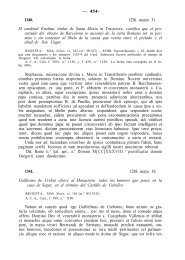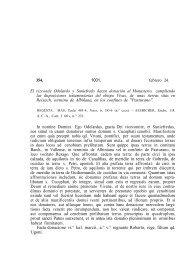Chapter 11 - The Library of Iberian Resources Online
Chapter 11 - The Library of Iberian Resources Online
Chapter 11 - The Library of Iberian Resources Online
Create successful ePaper yourself
Turn your PDF publications into a flip-book with our unique Google optimized e-Paper software.
THE LIBRARY OF IBERIAN RESOURCES ONLINE<br />
Emperor <strong>of</strong> Culture<br />
Robert I. Burns. S.J.<br />
<strong>Chapter</strong> <strong>11</strong><br />
Melodic Survivals?<br />
Kurt Schindler and the Tune <strong>of</strong> Alfonso X's<br />
Cantiga "Rosa das rosas" in Oral Tradition<br />
Israel J. Katz<br />
[159] In his last will and testament <strong>of</strong> 21 January 1284, written in Seville , seventy-four days before his<br />
death , Alfonso X decreed that all the Cantigas codices be housed in the cathedral <strong>of</strong> that city, where<br />
his body was to be interred and that the cantigas de loor should be sung in the cathedral on the feast<br />
days <strong>of</strong> the Virgin. [1] According to José M. Llorens Cisteró , the king's wish was honored on feast<br />
days, not only in the cathedral, during the procession, but also in religious ceremonies at court and in<br />
popular festivities (en algunas celebraciones religiosas de la corte y manifestaciones populares ). [2] By<br />
the middle <strong>of</strong> the fourteenth century, however, interest in the Cantigas had begun to decline until they<br />
were totally forgotten (empezaron a decaer en interés hasta quedar completamente olvidadas). [3]<br />
From John E. Keller's remarks, while not in full disagreement Llorens Cisteró , one senses the<br />
implication that the practice was from time to time and that "even now [cantigas are] sung [at the<br />
cathedral <strong>of</strong> Seville] to musical accompaniment." [4] Thus, any attempt to verify whether or not<br />
Alfonso's command was executed per annum, through the centuries, would necessitate a laborious and<br />
time-consuming perusal <strong>of</strong> the cathedral's Actas capitulares, particularly the entries for the feast days <strong>of</strong><br />
the Virgin: February 2, March 25, August 15, September 8, October 12, December 8. [5] Apart from<br />
Seville and Toledo where Alfonso held his court, information concerning when, where else, and how<br />
Alfonso's Cantigas were performed during his reign has to date yielded very little descript ive<br />
documentation <strong>of</strong> musicological significance, except for scanty iconographical evidence.<br />
One has only to view the physical appearance <strong>of</strong> any one <strong>of</strong> the extant [160] Cantigas codices bearing<br />
musical notation-ranging from 315 to 485 mm long and from 217 to 326 mm wide, and containing<br />
from 160 to 370 leaves <strong>of</strong> parchment-to realize how unwieldy each was for the solitary singer as well<br />
as the clarity <strong>of</strong> its notation if additional singers were huddled before it. This immediately calls to mind<br />
the larger and cumbersome cantorales, or choir books, such as those resting on facistolia (lecterns or<br />
choristers' desks) in the choir l<strong>of</strong>t <strong>of</strong> the royal monastery <strong>of</strong> El Escorial, around which several singers<br />
stood to sing from the same musical notation, inscribed on huge sheets <strong>of</strong> parchment. Whether such a<br />
group gathered around a Cantigas codex, or whether one singer, knowledgeable in reading its notation,<br />
taught selected texts and tunes to those gathered around him, remains an enigma. One can add to this<br />
problem such further speculations as those pertaining to performance practices, including dancing, with<br />
or without the accompaniment <strong>of</strong> musical instruments like those depicted in several <strong>of</strong> its miniatures,<br />
[6] as well as the manner <strong>of</strong> accompaniment.<br />
A closer study <strong>of</strong> the text-tune relationships <strong>of</strong> both the Marian miracles and the praises sung in her<br />
honor may even enable us to differentiate the poetic texts, for which their tunes were created
simultaneously, from texts which may have been suited to known melodies <strong>of</strong> the time taken from<br />
either liturgical or secular sources. At the same time, we can take into account their varied formal,<br />
modal, cadential , and intervallic structures,ambitus , syllable count, rhythmic features, mensural<br />
schemes, and versification. [7] <strong>The</strong> melodic origins <strong>of</strong> the Cantigas tunes await further investigation. [8]<br />
Moreover, considering the fact that the Galician-Portuguese dialect was neither the spoken nor even the<br />
written language <strong>of</strong> most Castilians, it is unlikely that even a handful <strong>of</strong> sung cantigas would have<br />
survived in oral tradition.<br />
Cantiga 10: "Rosa das rosas"<br />
Still, the possible instance <strong>of</strong> a cantiga tune surviving in oral tradition up to the third decade <strong>of</strong> the<br />
present century appears to have given rise to a few casual notices, even though its sung text is a<br />
Castilian translation <strong>of</strong> the original Galician-Portuguese. I am referring, <strong>of</strong> course, to Alfonso X's<br />
cantiga de loor 10 , "Rosa das rosas" (Figure <strong>11</strong>-1), which appears as no. 263 among the musical<br />
notations in Kurt Schindler's Folk Music and Poetry <strong>of</strong> Spain and Portugal, published posthumously by<br />
the Hispanic Institute <strong>of</strong> Columbia University in 1941 [9] (Example <strong>11</strong>-1b). Schindler collected the<br />
[161] cantiga in the town <strong>of</strong> Ceclavin, in western Cáceres near the Portuguese border, during his short<br />
visit there in the late summer <strong>of</strong> 1932. This was the period <strong>of</strong> Schindler's second field trip to Spain, [10]<br />
during which he transported a Fairchild portable recording apparatus for the purpose <strong>of</strong> gathering his<br />
material on aluminum discs. <strong>The</strong> label on disc no. 150A, containing "Rosa [de las r]osas , " cites<br />
Amado Vives Amores as Schindler's informant. Furthermore, in the text portion <strong>of</strong> his published<br />
collection, Schindler identified item 263 as "la Cantiga X del rey Don Alfonso el sabio, " yet he<br />
questioned whether it was "tradicional en Ceclavín." [<strong>11</strong>]<br />
Daniel Devoto, in his critical review, was the first to take note <strong>of</strong> its inclusion in Schindler's<br />
magnificent collection. He concluded that the text is traditional (folklórico) and relates to its original<br />
antecedent, the cantiga, despite the difficulty <strong>of</strong> proving it (es [de no establecerse una transmisión no<br />
tradicional ] folklórico, y cuenta con un antecedente, la cantiga original) . [12] Citing Devoto's<br />
reprinted version, Jacques Chailley concurred that "the cantiga 'Rosa das rosas' is preserved in Spanish<br />
oral tradition, and in Kurt Schindler's [book] it was collected as a popular song" ( s'est conservé dans la<br />
tradition órale espagnole, et a été recueilli comme chant populaire dans Kurt Schindler). [13] I initially<br />
agreed, including in my article not only Schindler's but also four additional modern transcriptions <strong>of</strong><br />
"Rosa das rosas" for comparative purposes. [14] In a recent critical study <strong>of</strong> Martin Codax's Cantigas de<br />
amigo, Manuel Pedro Ferreira included (in the first <strong>of</strong> three appendixes) a short discussion <strong>of</strong> "Rosa das<br />
rosas, " wherein he too expressed a similar view, while, at the same time, suggesting that the cantiga<br />
may have had its own manuscript tradition. [15] In support <strong>of</strong> this last position, Ferreira cited Luis<br />
Villalba's published arrangement <strong>of</strong> "Rosa das rosas" as the "manuscript" source <strong>of</strong> the Schindler tune,<br />
basing his evidence not on the tune, but on the comparison <strong>of</strong> the text underlays <strong>of</strong> their initial strophes.<br />
[16] <strong>The</strong> text for Villalba's setting had been Castilianized by R. de Valle; the deviations in Schindler's<br />
text are enclosed in brackets:<br />
Rosa, entre rosasFlor de las flores<br />
[de las]<br />
Virgen de vírgenes T amor de amores.<br />
[Amor]<br />
Rosa en que el Señor puso su querer<br />
Flor la más hermosa que se vió nacer
Virgen que hace dulce todo padecer<br />
[dulces todos los dolores]<br />
Amor que hace nuestros sus santos amores.
[165] Had Villalba known <strong>of</strong> the existence <strong>of</strong> the earliest Castilian version <strong>of</strong> the text, recently<br />
discovered by John Keller, [17] he might have placed it below the original text <strong>of</strong> his transcription as he<br />
had done with R. de Valle's translation. Thus, if both Schindler's and Villalba's text underlays had<br />
agreed closely with the medieval Castilian version, it would have indeed added weight to the<br />
speculative opinions registered above for an unbroken chain <strong>of</strong> oral transmission.<br />
According to Keller, the Castilianized poetic rendition <strong>of</strong> the original can be considered one <strong>of</strong> the<br />
earliest examples <strong>of</strong> thirteenth-century Castilian poetry, the first three stanzas <strong>of</strong> which are almost<br />
literal translations from the Galician:
[166] Following my publication <strong>of</strong> 1974, I was fortunate to acquire an entire set <strong>of</strong> program notes for<br />
the concerts presented by the Schola Cantorum <strong>of</strong> New York, under Schindler'sdirection (1912-1926).<br />
[20] <strong>The</strong>y werea ll written by Schindler, with occasional annotations by other authors. Among the [167]<br />
programs , theSchola's concert at Carnegie Hall on Wednesday evening, 21 January 1920, which<br />
exemplified the kind <strong>of</strong> programming that made this choral society one <strong>of</strong> the foremost in the nation,<br />
was included the first American performance <strong>of</strong> "Rosa das rosas. " This particular concert was divided<br />
in three parts: the first was devoted to Mozart's Requiem Mass., the second comprised "Three Ancient<br />
Melodies <strong>of</strong> the Church, " and the last was Handel's Ode on Saint Cecilia's Day.<br />
Schindler placed "Rosa das rosas" as the third <strong>of</strong> the "Ancient Melodies, " preceded by the Gregorian<br />
hymn "Ave maris stella" (from a ninth-century manuscript <strong>of</strong> the monastery <strong>of</strong> St. Gall) and the Introit<br />
" Rorate caeli " (for the fourth Sunday <strong>of</strong> Advent). Although mentioning Alfonso's Cantigas de Santa<br />
Maria as its original source, Schindler did not cite his direct source, that is, Villalba , upon which he<br />
based his choral arrangement; nor did he adhere strictly to the original text that was printed on the first<br />
page <strong>of</strong> Villalba's arrangement. Rather he presented his own edited version (variations shown below in<br />
bold characters) <strong>of</strong> the first and last strophes <strong>of</strong> the original Galician-Portuguese text (compare the<br />
versions just given):<br />
Rosa das rosas, et Flor das flores,<br />
Donna des donnas, Sennordas Sennores.<br />
Rosa das rosas...<br />
Rosa de beldad e de parecer,<br />
et Flor d'alegria et de placer;<br />
Donnaen mui piadosa seer,<br />
Señor en tollercuitas et dolores.<br />
Esta Donna que tengo por Sennor
et de que quiero seertrobador,<br />
se ioper resposs' aver su amor,<br />
dono al demo los otros amores.<br />
Schindler's own rather free translation was given as:<br />
Rose among roses, O sweetest <strong>of</strong> flowers,<br />
Chosen <strong>of</strong> women, to thee bring we homage.<br />
[168]<br />
Rose among roses...<br />
Rose <strong>of</strong> beauty, fairest vision,<br />
Mystic flower <strong>of</strong> purest joy,<br />
Holy essence thou <strong>of</strong> purest joy,<br />
Victor over pain and woe!<br />
To her service I have pledged me<br />
For to be her troubadour.<br />
If her love I could but gain me,<br />
Earthly loves would go for naught . [21]<br />
Schindler also added the following brief description :<br />
<strong>The</strong> Tenth Canticle from the "Cantigas de Santa Maria" <strong>of</strong> the King Alfonso el Sabio. (Spain,<br />
XIII Century). This is a song in praise <strong>of</strong> Saint Mary, <strong>of</strong> her marvellous goodness and <strong>of</strong> her<br />
great power.<br />
From the illustrated collection, containing poem and melody, in the castle <strong>of</strong> the Escorial,<br />
Madrid, Spain.<br />
Villalba arranged the cantiga for solo, chorus, and piano accompaniment. <strong>The</strong> opening refrain, which<br />
he designated as tiples, was to be sung by the sopranos and repeated by the chorus. <strong>The</strong> sopranos<br />
followed, singing the individual strophes to a harmonized piano accompaniment. Schindler, on the<br />
other hand, preferred an a cappella setting, having the contralto sing the opening refrain, which was<br />
repeated by the chorus, singing in octaves. <strong>The</strong> contralto then sang the two additional strophes that<br />
Schindler gave, with the chorus humming the exact harmonization Villalba had written for the piano<br />
(Example <strong>11</strong>-2).<br />
"Rosa das rosas" was performed again, six years later, at Carnegie Hall on Wednesday evening, 10<br />
March 1926. By some strange coincidence, it was sung at Schindler's final concert with the Schola<br />
Cantorum at Carnegie Hall. [22] He had resigned as its founder and musical director owing to a long<br />
dispute with the organization's governing board. In the accompanying program guide, Schindler<br />
provided a more elaborate, albeit somewhat inaccurate account <strong>of</strong> the collection from which the cantiga<br />
was taken, including comments about its author, whose degree <strong>of</strong> participation has been widely<br />
conjectured:<br />
King Alfonso the Wise <strong>of</strong> Castilla and León, who reigned in the middle <strong>of</strong> the XIII Century in<br />
his capital <strong>of</strong> Santiago de Compostella (the celebrated shrine <strong>of</strong> Spanish Galicia), [23] was not<br />
only a patron <strong>of</strong> poets and troubadours but also a deeply religious man. During his reign one <strong>of</strong><br />
the foremost manifestations <strong>of</strong> mediaeval religious poetry took place: a collection <strong>of</strong> more than<br />
four hundred songs and canticles in praise <strong>of</strong> the Virgin Mary was issued in magnificent
volumes illustrated by exquisite miniature painting. <strong>The</strong> authorship <strong>of</strong> the canticles was<br />
attributed solely to the King, although we may easily [170] surmise that he was helped by his<br />
court <strong>of</strong> poets and troubadours, among whom he is shown seated in paintings <strong>of</strong> the period.<br />
Only two specimens <strong>of</strong> the complete collection have been preserved to posterity, one in the<br />
library <strong>of</strong> the Escorial near Madrid, the other at the Vatican in Rome. <strong>The</strong> text <strong>of</strong> the canticles<br />
(in the old Galician court language, an idiom very nearly related to Portuguese, but retaining a<br />
great many traces <strong>of</strong> pure Latin) has been reprinted in a modern edition, [24] and the<br />
illuminated pictures can be seen in photographic reproductions at the Museum <strong>of</strong> the Hispanic<br />
Society <strong>of</strong> America, for which they were ordered by Mr. Archer M. Huntington [25] Apart from<br />
their artistic charm and interest, these pictures represent one <strong>of</strong> the foremost sources <strong>of</strong><br />
information regarding the musical instruments <strong>of</strong> the Middle Ages.<br />
But the most interesting part <strong>of</strong> the collection is its music, since every canticle is accompanied<br />
by a particular melody written in neumatic notation. <strong>The</strong> deciphering <strong>of</strong> the ' Neumes ' has long<br />
been a puzzle to scholars and has given rise to some extraordinary theories and aberrations.<br />
<strong>The</strong> late wizard <strong>of</strong> Spanish music, Felipe Pedrell,never quite succeeded in finding the key to<br />
the code. Julián Ribera, a foremost Arabic scholar <strong>of</strong> Madrid University, produced and<br />
published grotesque and purely theoretical paraphrases <strong>of</strong> them, but two less known scholars<br />
succeeded in reading some <strong>of</strong> the melodies in most convincing fashion: the late Padre Villalba,<br />
who deciphered 'Rosa das Rosas, ' and D. Francesch Pujol, who decoded the melody <strong>of</strong> the<br />
"Miracle <strong>of</strong> the Virgin" [cantiga 139: Maravillosos et piadosos]. [26]
It is strange that Schindler should level such criticism at Ribera, whose study <strong>of</strong> the Cantigas appeared<br />
four years earlier in 1922. It was not until the year after Schindler's comments that Anglés published<br />
the first <strong>of</strong> his articles, dealing with the Cantigas, wherein he attacked Ribera's transcriptions. [27] I<br />
would venture a guess that Schindler picked up the criticism <strong>of</strong> Pedrell and Ribera from either Gregorio<br />
María Sunyol'sarticle <strong>of</strong> 1924 or Manuel F. Ferná ndez- Núñez's article <strong>of</strong> 1924-1925. [28] One cannot<br />
be sure <strong>of</strong> Schindler's acquaintance with the two-volume Real Academia Española 1889 edition <strong>of</strong> the<br />
text <strong>of</strong> the Escorial codex B. I. 2, [29] for which Ribera's edition <strong>of</strong> 1922 constituted the third volume, or<br />
with the studies <strong>of</strong> Pierre Aubry (1907), and <strong>of</strong> Henri Collet with Luis Villalba (19<strong>11</strong>). [30] What is<br />
certain is that Schindler came upon Villalba's arrangement <strong>of</strong> cantiga 10 some time in 1917 or earlier.<br />
From the evidence presented above, it appears that Schindler was already familiar with "Rosa das<br />
rosas" long before he recorded it in Cáceres. <strong>The</strong> evidence also explains why he questioned whether it<br />
was traditional there. It is also clear that Schindler's informant was acquainted with the Castilian text <strong>of</strong><br />
Villalba's arrangement. Either he had heard it on repeated occasions or may even have sung it as a<br />
member <strong>of</strong> some chorus, though his tonal memory appears to have faltered with the passage <strong>of</strong> time.<br />
While [171] Schindler himself seems to have supported the notion that the cantiga survived in oral<br />
tradition, I suspect that, had Schindler lived to complete the in-depth musicological study which his<br />
collection lacks, he would have attempted to examine the possible transmission <strong>of</strong> the cantiga through<br />
the centuries.<br />
Ferreira's suggestion, linking the cantiga collected in Cáceres with Villalba's arrangement as having its<br />
own manuscript tradition, is plausible. However, I would prefer a linkage that was more historically<br />
bound, one which can be applied to any <strong>of</strong> the miracles and cantigas de loor that had undoubtedly<br />
circulated in this manner-that is, after having been copied from any <strong>of</strong> the original codices bearing<br />
musical notation. Wherever they were circulated, during the generations that followed, there were<br />
bound to occur textual and melodic discrepancies owing to the very nature <strong>of</strong> oral transmission.<br />
Doubtless this process also occurred, but exactly when and where it began its gradual to almost total<br />
decline are difficult to ascertain. Such questions hinge on the popularity <strong>of</strong> particular texts and/or tunes<br />
as well as events to which they were linked, the verification <strong>of</strong> which is virtually impossible.<br />
Nonetheless, several scholars have noted that Cantigas tune variants eventually made their way into<br />
regional dance repertoires, or survived as instrumental music or to an even lesser extent as tune contra<br />
facts. [31] Still, with due respect to the conclusions drawn above concerning Schindler's published field<br />
notation, Ferreira's alternate suggestion more accurately describes the by no means coincidental<br />
relationship between the cantiga Schindler collected in Cáceres and Villalba's arrangement. Inasmuch<br />
as a manuscript tradition carries with it the factor <strong>of</strong> continuity, in our case this factor must be<br />
discounted. A more plausible explanation would take into account attempts to resurrect the longdormant<br />
Cantigas tradition, which reflected deeply rooted religious sentiments, as a vehicle to arouse<br />
nationalistic sentiments as well.<br />
<strong>The</strong> earliest vocal settings <strong>of</strong> cantigas can be found among a collection <strong>of</strong> seventeenth- and eighteenthcentury<br />
notebooks at the Biblioteca Nacional in Madrid, which contain mainly settings for soprano and<br />
continuo that were made by an anonymous composer, and the notebook in which they are found was<br />
entitled "Música española" by Francisco Asenjo Barbieri. "Rosa das rosas" is one <strong>of</strong> the eleven cantigas<br />
contained therein. [32] In 1855, Mariano Soriano Fuertes published settings for eight <strong>of</strong> the eleven<br />
cantigas, excluding "Rosa das rosas," with continuo accompaniment. [33] <strong>The</strong> earliest modern musical
composition based on a cantiga tune was that <strong>of</strong> Hilarión Eslava (c. 1861 ?). [34] From the turn <strong>of</strong> the<br />
century to the early 1930s, there followed arrangements <strong>of</strong> selected Cantigas melodies by Luis Villalba<br />
(one [172] being that <strong>of</strong> the cantiga under discussion), Felipe Pedrell, and Tomás Bretón, [35] including<br />
transcriptions <strong>of</strong> various cantigas made by such renowned musicologists as PierreAubry , the Arabist<br />
Julián Ribera, Gregorio María Sunyol, and J.B. Trend. [36] Trend based most <strong>of</strong> his transcriptions on<br />
those <strong>of</strong> Aubry , reworking several <strong>of</strong> them. Thus, by the time Schindler collected "Rosa das rosas, "<br />
there was a goodly amount <strong>of</strong> interest in the Cantigas repertory, and this undoubtedly prompted Angles<br />
to undertake his monumental study. His transcription <strong>of</strong> the entire corpus was to become the basis for<br />
the present and continued resurgence <strong>of</strong> cantigas performances throughout the world. [37]<br />
Possible Textual and Melodic Antecedents<br />
Jacques Chailley pointed out Alfonso's literal paraphrase <strong>of</strong> "Rose des roses et fleurs des fleurs " from<br />
the sixth verse <strong>of</strong> Gautier de Coinci's Chanson á la Vierge, "Quant ces floretes florir voi." 38] It is likely<br />
that Alfonso was inspired by this verse, which he developed into a full-fledged song in praise <strong>of</strong> the<br />
Virgin and which, together with Prologue B, cantiga de loor 1, and the Petiçon (cantiga 401),<br />
constitutes the strongest grounds for attributing his authorship to these particular examples.<br />
In a recent article I alluded to the ninth-century sequence " Victimae paschali laudes " (Example <strong>11</strong>-3c)<br />
as a possible source or inspiration for "Rosa das rosas" (Example <strong>11</strong>-3a, taken from the Toledo codex,<br />
dating from around 1257), whose melodic incipit it closely resembles. [39] For the Example <strong>11</strong>-3b<br />
(taken from Escorial B.1 2), the Argentine musicologist Josué T. Wilkes (1942) found additional<br />
melodic similarities in the antiphons "Magnum haereditatis mysterium " (Example <strong>11</strong>-3f) and "In<br />
patientia vestra " (Example <strong>11</strong>-3e), [40] to which I add the antiphon " Juste et pie vivamus " (Example<br />
<strong>11</strong>-3d). <strong>The</strong>se can be seen in the Liber usualis. Even the melodic incipit <strong>of</strong> the thirteenth-century<br />
sequence, " Stabat Mater" (Example <strong>11</strong>-3g), attributed to the Franciscan Jacopone da Todi (c. 1228-<br />
1306) and which also may have been inspired by the earlier ninth-century sequence, is much closer to<br />
the Escorial version <strong>of</strong> "Rosa das rosas" which dates from around 1281.<br />
With regard to the form <strong>of</strong> the cantiga, Anglés placed "Rosa das rosas" in the category <strong>of</strong> virelais and<br />
mentioned that it was similar in structure to cantiga 64, " Quen mui benquiser." In his analysis <strong>of</strong> the<br />
refrain and stanzas, he counted, according to the rules <strong>of</strong> versification, an average <strong>of</strong> ten syllables per<br />
line <strong>of</strong> verse, save the initial one. Yet a careful reading <strong>of</strong> the second [173] line <strong>of</strong> refrain bears out the<br />
fact that it contains eleven syllables. Moreover, Anglés used Greek letter to designate the corresponding<br />
melody phrase for each verse. [41]<br />
Rhyme Scheme Melody<br />
Rosa das rosas e Fror das frores A 9 a<br />
Dona das donas, Sennor das sennores A <strong>11</strong> ß<br />
Rosa de beldad' e de parecer b 10 g<br />
e Fror d'alegria e de prazer b 10 g<br />
Dona en mui piadosa seer, b 10 d<br />
Sennor en toller coitas e doores a 10 ß
42. Ribera's transcription was printed without a text underlay .<br />
43. <strong>The</strong> Castilian version was made by Ernesto Mario Barreda.<br />
44. In Anglés's transcription <strong>of</strong> To and B.I.2, their differences are reflected in the transposition (To is a<br />
4th higher) and in bars 2, 8, and 19.<br />
45. E. López Chavarri duplicated Villalba's transcription in his Historia de la música (Barcelona: Hijos<br />
de Paluzí, 1921), 1: facing p. 156.<br />
46. <strong>The</strong> first two measures <strong>of</strong> Pedrell's arrangements indicate that he used Aubry's transcription ; see<br />
Higinio Anglés , Cataleg dels manuscrits musicals de la Col- lecció Pedrett (Barcelona: Institut<br />
d'Estudis Catalans , 1920), 79.<br />
47. See Anglés above in n. 46. Anglés's transcription <strong>of</strong> the cantiga 10 from B.I.2 was subsequently<br />
utilized by: ( 1 ) Reese, Music in the Middle Ages, 247, who obtained it from Anglés's unpublished<br />
paper, "La notación mensural de la módica de la corte española del siglo XIII <strong>of</strong>rece soluciones nuevas,<br />
hasta hoy totalmente desconocidas, para la interpretación est ético-rítmica de las melodías de los<br />
trovadores," a discourse delivered by proxy to the American Musicological Society <strong>of</strong> New York,<br />
September 1939; (2) José María Lamaña , Canciones de la Andalucía medieval y renacentista (siglos<br />
XIH-XVI) para canto y piano (Madrid: Unión Musical Española, 1968), 1, who transposed it up a<br />
major 2nd, with minor alterations ; (3) Venancio G. Velasco, Rosa das rosas (cantiga de Santa María)<br />
(Madrid: Unión Musical Española, 1973), who employed it in his arrangement for guitar, transposed up<br />
a major 3rd and renotated in a strict 6/4 meter; and (4) Mariano Pérez Gutiérrez, "Rosa das rosas<br />
(armonización modal), Op. 56, (unpublished manuscript dated 1967), who arranged it for mezzosopprano<br />
and four-part chorus, a cappella. It should also be noted that the portion accompanying the<br />
text "Rosa de beldad' e ... et de prazer " in Anglés's transcriptions (Example <strong>11</strong>-4, d and i ) duplicates<br />
that made earlier by Friedrich Ludwig: see Guido Adler , Handbuch der Musikgeschichte , 2nd edn.
(Frankfurt am Main: Hess, 1930), 1: 213.
[180] A more accurate analysis <strong>of</strong> the musical structure<strong>of</strong> the cantiga requires a subdivision <strong>of</strong> each<br />
verse, as reflected in the musical transcriptions made from the Cantigas codices in Example <strong>11</strong>-4. <strong>The</strong><br />
first textual strophe is also problematic, specifically its second and third verses, wherein the division <strong>of</strong><br />
their lines necessitates six and four syllables per melody phrase. Also notice how the initial melody<br />
phrase <strong>of</strong> the third verse ends on the second syllable <strong>of</strong> the word piadosa.<br />
Rosa das rosas<br />
e Fror das frores<br />
Dona das donas.<br />
Sennor das sennores.<br />
Poetic Structure Melodic Structure<br />
A <strong>11</strong>(5+5)<br />
A <strong>11</strong>(5+6)<br />
A x+w<br />
A x+y<br />
B<br />
A x+z
Rosa de beldad'<br />
e de parecer<br />
e Fror d'alegria<br />
e de prazer,<br />
Dona en mui pia-<br />
dosa seer,<br />
Sennor en toller<br />
coitas e doores<br />
b 10(5+5)<br />
b 10(6+4<br />
b 10(6+4)<br />
a 10(5+5)<br />
C<br />
B'<br />
C<br />
B'<br />
E<br />
F<br />
B<br />
A x+y<br />
<strong>The</strong> only melodic discrepancy that exists between "Rosa das rosas" <strong>of</strong> the Toledo (To) and Escorial (B.<br />
I. 2. ) codices can be found in the initial melody phrase, above the syllable " ro " (see Example <strong>11</strong>-4). In<br />
the former codex, the two-note ligature above that syllable is podatus (b-flat-c; or f-g, transposed down<br />
a perfect 4th), whereas in the latter, it is a three-note ligature, scandius (e-f-g). It is possible, as Josué T.<br />
Wilkes suggested, that this was the cause <strong>of</strong> scribal error, "by mere recollection, not totally exact" (por<br />
simple recordación, no por curto exacta ) , even though two distinct notational systems were employed,<br />
the earlier <strong>of</strong> which the scribe may not have taken care to verify. [42]<br />
To Collet and Villalba's statement that the melodic incipit <strong>of</strong> "Rosa das rosas" is a general formula <strong>of</strong><br />
plain chant in the Dorian mode (" est une formule genérale de plain-chant ( I er mode 'gravis' [the<br />
Dorian mode])"), Wilkes responded:<br />
Rather than a general formula that usually comprises but three or four principal tones<br />
within the ecclesiastical modality, the tune <strong>of</strong> the cantiga would have suggested to the<br />
composer any one <strong>of</strong> the melodies from the Christian liturgy. [43]<br />
[181] Yet the most crucial element distinguishing Schindler's example and Ribera's<br />
transcription from the others is modality. We have speculated earlier that Schindler's<br />
informant may have been acquainted with Ribera's transcription, thus explaining their<br />
common modality (D minor, with a raised 7th), which would seem to be more than<br />
coincidental. Be that as it may, Ribera's transcriptions <strong>of</strong> the Toledo codex have<br />
continued to provoke criticism, and Wilkes has devoted a major part <strong>of</strong> his article to<br />
condemning Ribera's views on modality. 44<br />
Of all the literary and scientific works produced under the sponsorship <strong>of</strong> Alfonso X the Wise, the<br />
Cantigas de Santa Maria remained his most cherished. <strong>The</strong> performances <strong>of</strong> songs from this unique<br />
collection, which was compiled, ordered, and lavishly illustrated under his supervision, continue to<br />
delight audiences throughout the world. Schindler himself was responsible for such performances; all<br />
the same, he was truly excited when he confronted the tune in what he believed to be "oral tradition. "<br />
Nonetheless, one can only hope that this and other tunes from the collection are still lurking<br />
somewhere on the <strong>Iberian</strong> peninsula.<br />
Notes for <strong>Chapter</strong> Eleven<br />
[1] . Alfonso's text reads: "Otros í mandamos, que todos los libros de los Cantares de loor de Santa<br />
Maria sean todos en aquella iglesia de nuestro cuerpo se enterrare, e que los fagan cantar las fiestas de<br />
Sancta Maria. E si aquel que lo nuestro heredare con derecho e por nos, quisiere haber estos libros de<br />
los Cantares de Sancta Maria, mandamos que faga por ende bien et algo a la iglesia onde los tomare<br />
porque los haya con merced e sin pecado." See Alfonso X, Antología ( ed . A. G. Solalinde , Madrid:
Espasa - Calpe , 1942, Colección Austral, vol. 169), 236.<br />
<strong>The</strong> books to which Alfonso referred comprise the four extant codices <strong>of</strong> Cantigas de Santa<br />
Maria (see above, ch . 4, n. i ). Two <strong>of</strong> them are located at the Biblioteca de San Lorenzo el Real at El<br />
Escorial near Madrid ( B.I .2 [formerly j.b .2] and T.I.1 [formerly T.J.1], respectively), a third at the<br />
Biblioteca Nacional, Madrid ( B.N . MS 10.069), and the fourth at the Biblioteca Nazionale, Florence<br />
(MS Banco Rari 20). Alfonso had the latter version prepared as a gift to his cousin, Louis IX <strong>of</strong><br />
France ( Keller,. Alfonso X, 69). All but the Florentine codex bear musical notations; however, only its<br />
staff lines had been inscribed, examples <strong>of</strong> which can be seen for cantigas1 and 14 in two plates<br />
supplied by Solalinde in his description <strong>of</strong> this codex. See Solalinde , "El códice florentino de las<br />
Cantigas y su relación con los demás manuscritos," RFE 5 (1918): insert between 152-53.<br />
<strong>The</strong> cantigas de loor, which are the songs sung in praise <strong>of</strong> the Virgin Mary, begin with cantiga 1,<br />
after which, commencing with cantiga 10, they constitute every tenth cantiga throughout the<br />
remainder <strong>of</strong> the collection. <strong>The</strong>se have been studied by Joseph T. Snow in his "<strong>The</strong> Loor to the<br />
Virgin and Its Appearance in the Cantigas de Santa Maria <strong>of</strong> Alfonso X, el Sabio" (Ph.D. diss .,<br />
University <strong>of</strong> Wisconsin, 1972). In Codex B.I.2, each <strong>of</strong> the cantigas de loor bear the miniatures <strong>of</strong><br />
the instrumentalists as their initial vignettes.<br />
[2] . José M. Llorens Cister El "Códice Rico" de las Cantigas de Alfonso el Sabio, supplementary<br />
volume to the facsimile edition <strong>of</strong> the Escorial manuscript (see above, ch . 4, n. 2), 321-96, opinion on<br />
331.<br />
[3] . Ibid .<br />
[4] . Keller , in Studies on the Cantigas (see above, ch . 1, n. 2), <strong>11</strong>.<br />
[5] . Robert Stevenson undertook an investigation <strong>of</strong> the cathedral's actas capitulares catedralicias for<br />
the years 1478 through 1606 by extracting information linking the musical life <strong>of</strong> the incipient<br />
cathedral <strong>of</strong> Mexico with that <strong>of</strong> the cathedral <strong>of</strong> Seville, upon which it was modeled (cf. La Música<br />
en la Catedral de Sevilla, 1478-1606: Documentos para su estudio, 2nd. edn . [Madrid: Sociedad<br />
Española de Musicología, 1985]). In his extractions, no mention is made <strong>of</strong> musical performances,<br />
even for the few entries coinciding with the feast days <strong>of</strong> the Virgin.<br />
[6] . Codex T.I.1 , fol. 5, cantiga 8 (panels 1-5, depicting the minstrel Pedro Desigrad ); cantiga de<br />
loor 100 (panel 6, depicting angels singing, while a consort, comprising instruments <strong>of</strong> Eastern origin,<br />
accompanies them); cantiga 194 (panel 2), cantiga de loor 120 (panel 1), and Codex B.I.2, fol. 29v.<br />
[7] . Ismael Fernández de la Cuesta studied both the intervals and ambitus <strong>of</strong> the Cantigas melodies in<br />
his "La interpretación melódica de las Cantigas de Santa María," in Studies on the Cantigas, 155-88.<br />
Gerardo V. Huseby, in "<strong>The</strong> 'Cantigas de Santa Maria' and the Medieval <strong>The</strong>ory <strong>of</strong> Modes" (Ph.D. diss<br />
., Stanford University, 1982), studied their modes. <strong>The</strong> controversies concerning their rhythm were<br />
taken up by J. M. Llorens Cisteró , in "El ritmo musical de las Cantigas de Santa Maria: estado de la<br />
cuestión," Studies on the Cantigas, 203-21. Huseby added a further contribution, "Musical Analysis<br />
and Poetic Structure in the Cantigas de Santa Maria,'" in Florilegium Hispanicum : Medieval and<br />
Golden Age Studies Presented to Dorothy Clotelle Clarke, ed. John S. Geary, et al. (Madison, Wisc.:<br />
Hispanic Seminary <strong>of</strong> Medieval Studies, 1983), 81-101. For a classic study regarding their
versification, see Dorothy Clotelle Clarke, "Versification in Alfonso el Sabio's Cantigas," Hispanic<br />
Review 23 (1955): 83-98.<br />
[8]. See my article , "Higinio Angles and the Melodic Origins <strong>of</strong> the Cantigas de Santa María " in<br />
Alfonso X the Learned King--An International Symposium, Harvard University, 17 November 1984,<br />
ed. Francisco Márquez Villanueva (Cambridge, Mass.: Studies in Romance Languages Series,<br />
Harvard University, 1989), 46-75.<br />
[9] . Folk Music and Poetry <strong>of</strong> Spain and Portugal, with an introduction on Kurt Schindler and his<br />
Spanish work (in English and Spanish ) by Federico de Onís (New York: Hispanic Institute, 1941).<br />
Onís , then chairman <strong>of</strong> the Spanish department at Columbia University, supervised the final editing <strong>of</strong><br />
Schindller's field notations. Concerning its publication, see my article '<strong>The</strong> Posthumous Publication <strong>of</strong><br />
Kurt Schindller's Folk Music and Poetry <strong>of</strong> Spain and Portugal (New York, 1941)," in Libraries,<br />
History, Diplomacy, and the Performing Arts; Essays in Honor <strong>of</strong> Carleton Sprague Smith, ed. Israel<br />
J. Katz (Stuyvesant, N.Y.: Pendragon , forthcoming).<br />
[10] . <strong>The</strong> second field trip took place between July 1932 and December 1933, under the auspices <strong>of</strong><br />
Columbia University . <strong>The</strong> first trip , which took place between the fall <strong>of</strong> 1928 and fall <strong>of</strong> 1931, was<br />
unsponsored .<br />
[<strong>11</strong>] .Schindler, Folk Music and Poetry , 18.<br />
[12] . Devoto, "Sobre la música tradicional española,"EFE 5 (1943): 344-66, esp. 352, n. 1. Reprinted<br />
in Devoto, Las hojas (1940-1949) (Buenos Aires: Aldabahor , 1950): 24-48, esp. 36, n. 18.<br />
[13] .Les Chansons a la Vierge de Gautier de Coinci (<strong>11</strong>77/78-1236), ed. Jacques Chailley (Paris:<br />
Huegel , 1959), 45, n. 1.<br />
[14] . Katz, "<strong>The</strong> Traditional Folk Music <strong>of</strong> Spain: Explorations and Perspectives," Yearbook <strong>of</strong> the<br />
International folk Music Council 6 (1974): 64-85, esp. 78. <strong>The</strong> other transcriptions were made by (i)<br />
Fierre Aubry, " Iter Hispanicum . Notices et extraits de manuscripts de musique ancienne conserves<br />
dans les bibliothéques d'Espagne. III. Les Cantigas de Santa Maria de don Alfonso el Sabio," Sammelbänder<br />
der intemationalen Musik-Gesellschaft (1907): 32-51, esp. 43; (2) Julián Ribera Tarragó, La<br />
música de las Cantigas: estudio sobre su origen y naturaleza, with photographic reproductions <strong>of</strong> the<br />
text and in modern transcription, volume three <strong>of</strong> the Las Cantigas de Santa María, Real Academia<br />
Española edn. (Madrid: Revista de Archivos, 1922), 127-28; (3) John Brande Tend, <strong>The</strong> Music <strong>of</strong><br />
Spanish History to 1600 (Oxford: Oxford University Press, 1926), 206 (after Aubry); and (4) Higinio<br />
Anglés, taken from Gustave Reese, Music in the Middle Ages (New York: W.W. Norton, 1940), 247.<br />
[15] . Manuel Pedro Ferreira, <strong>The</strong> Sound <strong>of</strong> Martin Codax : On the Musical Dimension <strong>of</strong> the<br />
Galician-Portuguese Lyric (XII-XIV Century) (Lisbon: Unisys, Imprensa Nacional --Casa da Moeda ,<br />
1986), bilingual edition, 190. Facing Schindler's transcription (which he transposed down a major<br />
2nd), Ferreira provided his own <strong>of</strong> cantiga 10, from the Toledo codex, which he presumed to be the<br />
oldest <strong>of</strong> the extant codices.
[16] . Luis P. Villalba Muñoz, Cantigas a la Inmaculada Virgen Maria: cantiga X de el rey D . Alfonso<br />
el Sabio (Madrid: Ildefonso Alier , 190?).<br />
[17] . Keller , " An Unknown Castilian Lyric Poem : <strong>The</strong> Alfonsine Translation <strong>of</strong> Cantiga X <strong>of</strong> the<br />
Cantigas de Santa Maria," Hispanic Review 43 (1975): 43-47. Keller discovered the poem among the<br />
Castilian prosifications <strong>of</strong> the first twenty-six cantigas, which, according to recent investigations,<br />
could have been made during the reign <strong>of</strong> Sancho IV (1284- 1295), by Sancho himself, or by Alfonso's<br />
nephew, Juan Manuel (1282-1348/49), or perhaps much later. For a discussion <strong>of</strong> the prosifications,<br />
see Anthony C á rdenas, "A Study <strong>of</strong> Alfonso's Role in Selected Cantigas and the Castilian<br />
Prosifications <strong>of</strong> Escorial Codex T.I.1," in Studies on the Cantigas, 248-68.<br />
[18] . Compare Keller's textual transcription with that <strong>of</strong> José Filgueira Valverde, Alfonso X el Sabio.<br />
Cantigas de Santa María (Madrid: Editorial Castalia, 1985), 352. For modern Castilianized versions,<br />
see Angel del Río, Antología general de la literatura española (New York: Holt, Rinehart and<br />
Winston, 1960), 1: 50-51, and Filgueira Valverde, Alfonso: Cantigas, 29. See also the instructive<br />
comments on the text by Augusto J. Magne , " Afonso X, o Sabio. Excerptos anotados," Revista da<br />
lingua portuguesa 8/44 (1926): 55-<strong>11</strong>0, esp. 68-69.<br />
[19] . <strong>The</strong> text is taken from Walter Mettmann , Alfonso X, el Sabio. Cantigas de Santa Maria<br />
(cantigas 1 a 100) (Madrid: Editorial Castalia, 1986), 84-85. Mettmann , "Die altportugiesische<br />
Marienlyrik vor 1300," in Grundriss der romanischen Literaturen des Mittelalters , ed. H. H. Jauss<br />
(Heidelberg: Carl Winter, 1968), 18, cites Sennor and Sennor das Sennores among the most traditional<br />
names and Marian epithets and refers to the phrases <strong>of</strong> the first textual strophe "Rosa das rosas, etc."<br />
as Hebrew superlatives.<br />
[20] . This was given to me as a gift by Hugh Ross, Schindler's successor at the Schola Cantorum.<br />
[21] . For other free as well as literal English translations, see (1) Robert Eisenstein, Program notes<br />
for the Folger Consort's program "A Medieval Tapestry" presented at Corpus Christi church (New<br />
York, Sunday, 27 November 1983), 5; (2) Kathleen Kulp -Hill, Cantigas (see above, ch . 4, n. 13),<br />
109; (?) Lorraine Noel Finney, in Reese, Music in the Middle Ages, 248; (4) Medieval Lyrics <strong>of</strong><br />
Europe, ed. Willard R. Trask (New York: World Publishing Co., 1969), 130; and (5) Américo Castro,<br />
<strong>The</strong> Structure <strong>of</strong> Spanish History, trans. Edmund L. King (Princeton: Princeton University Press,<br />
1954), 362.<br />
[22] Officially, his final concert with the Schola Cantorum took place ten days later at the high school<br />
auditorium in Summit, New Jersey.<br />
[23] . This certainly is not true. During Alfonso's reign (1252-1284), there was no fixed capital.<br />
Seville, however, was the most favored city <strong>of</strong> the court.<br />
[24] . He is referring here to Las Cantigas de Santa Maria de Alfonso el Sabio, ed . Leopoldo Augusto<br />
de Cueto, Marqués de Valmar, 2 vols. (Madrid: Real Academia Espa ñ ola, 1889).<br />
[25] . Schindler was ignorant <strong>of</strong> the existence <strong>of</strong> the four extant Cantigas codices. At the Hispanic<br />
Society, the former work can be seen in a photographic copy under the call name Cantigas de Santa
Maria MS T.J.1 (Escorial thirteenth century). It is the only Cantigas codex for which photocopies<br />
exist. <strong>The</strong> latter, the Vatican compilation, to which Schindler alluded, may be that <strong>of</strong> the Cancioneiro<br />
de Vaticana (Vatican MS 4803), which does not contain any <strong>of</strong> the Cantigas de Santa Maria , but<br />
rather fifteen <strong>of</strong> Alfonso's cantigas pr<strong>of</strong>anas (nos. 61-79), some <strong>of</strong> which are cantigas de mal- dezir or<br />
mal- decir , i.e., "cántigas en las que se maldice de algo, sino cantigas escritas con palabras obsenas ,<br />
género que cultivaban la mayoría de los trovadores gallego-portugueses, incluso el piadoso D. Alfonso<br />
X el Sabio" (Eugenio López Aydillo , Las mejores poesías gallegas [Madrid: Imprenta Artística<br />
Española, 1914], 173, n. 9). <strong>The</strong>re are no photographic reproductions <strong>of</strong> this work at the Hispanic<br />
Society. See also Francisco Márquez Villanueva, "Las lecturas del deán deCadiz en una cantiga de mal<br />
dizer ,'" in Studies on the Cantigas, 329-54.<br />
[26] . Schindler created an eight-part setting a cappella, with soprano and baritone as narrators, to<br />
open the first Spanish concert <strong>of</strong> the New York Schola Cantorum at Carnegie Hall, Tuesday evening,<br />
15 January 1918. <strong>The</strong> arrangement was based on Pujol's transcription, which was printed in Lluis<br />
Millet's article, "<strong>The</strong> Religious Folk-Song <strong>of</strong> Spain," printed in the Actas <strong>of</strong> the Third National<br />
Congress <strong>of</strong> Sacred Music, held in Barcelona in November 1912. Schindler's arrangement, according<br />
to the program notes (p. 3) <strong>of</strong> 10 March 1926 was also "sung in Madrid by a chorus <strong>of</strong> four hundred<br />
voices under the direction <strong>of</strong> Padre Nemesio Otaño on the Tercentenary <strong>of</strong> the death <strong>of</strong> Saint Ignacio<br />
de Loyola." Had this been the occasion, the year should have been 1856, for Ignacio died in 1556.<br />
Pujol's transcription <strong>of</strong> the tune can also be found in Trend, Music <strong>of</strong> Spanish History, 205.<br />
[27] . See Anglés, "Les ' Cantigues ' del rey N'Anfós el Savi," Vida cristiana (Barcelona) 14 (1926-<br />
1927) nos.109-16:1-64.<br />
[28] . Sunyol , " antigues de Montserrat del rei Anfós, dit 'el Savi'," Analecta montserratensia 5<br />
(1924): 361-417. Fernández Núñez, "Las canciones populares y la tonalidad medieval, aclaraciones a<br />
la obra Las Cantigas de Santa Maria escrita por D. Julián Ribera," La Ciudad de Dios 138 (1924):<br />
273-83, 343-52; 139 (1924): 33-38, 97-<strong>11</strong>0, 353-60; 140 (1925): 102-13; 141 (1925): 426-35; 142<br />
(1925): 422-34; and 143 (1925): 134-45, 209 -21 reprinted as a booklet (El Escorial: Monasterio de<br />
Escorial, 1924-1925). <strong>The</strong> article <strong>of</strong> Fernández Núñez, which contains a more vehement attack, is<br />
poorly documented.<br />
[29] . See Cueto, above in n. 24.<br />
[30] . For Aubry see above , n. 14. Collet and Villalba, "Contribution a l'étude des Cantigas<br />
d'Alphonse le Savant d'après les códices de l'Escurial ," Bulletin hispanique 13 (19<strong>11</strong>): 270-90.<br />
[31] . Discussed in Katz , "Anglés and Melodic Origins," 61-63.<br />
[32] . <strong>The</strong> call number for the notebook is M. 3881/8. "Rosa das rosas" can be found on folio 3r. It is<br />
unfortunate that I was unable to photocopy the melody. See the commentary <strong>of</strong> Angles and José<br />
Subirá, Catálogo musical de la Biblioteca nacional de Madrid, 1: Manuscritos (Barcelona: Instituto<br />
Español de Musicología, 1946), 281-83. See also Anglés, La música, 2: 16-17, n. 2.<br />
[33] . Soriano Fuertes, Historia de la música española desde la venida de los fenicios hasta el año
1850 (Madrid: Martín y Salazar, 1855), 1:109ff. and the apéndice musical. He claimed to have taken<br />
them from the so-called Cancionero de Marialva , which belonged to D. Francisco Contino, Conde de<br />
Marialva , and which to date has not been located. See Anglés/Subiá , Catálogo musical, 1: 281-83,<br />
and Anglés, La música, 2: 16-17, n. 2.<br />
[34] . Hilarión Eslava, Cantiga 14 del rey don Alfonso el Sabio, parafraseada con coros y orquesta<br />
(Madrid: Fétis , [1861?]). Joseph Snow, <strong>The</strong> Poetry <strong>of</strong> Alfonso X, El Sabio: A Critical Bibliography<br />
(London: Grant and Cutler, 1977), no. 31, who did not see this composition, cites (Antonio) Palau (y<br />
Dulcet), Manual [del librero hispano-americano, 2nd edn . (Barcelona: A. Palau, 1948)], 1 : 206,<br />
where it is listed as item 7136. Snow (no. 71) also suggested that Felipe Pedrell's Seis cantigas,<br />
transcriptas y harmonizadas con acompañadp de órgano o harmonio. Textos orginales y versiones en<br />
castellano (Barcelona: Vidal Llimona y Boceta, 1905-101?) "probably appeared first, singly, in the<br />
review Salterio Sacro Hispano, ca . 1882 -83."<br />
[35] . See Villalba above in n. 16. Pedrell , Cancionero musical popular español (Madrid: J.<br />
Fernández Arias, 1914), 1: nos. 145-48; 3 ( Vails , Spain: Eduard Castells , 1920): nos. 1-4. For<br />
information concerning Breton's settings, see Julián Ribera Tarrago, "Valor de la música de las<br />
Cantigas," in Discursos leídos ante S. M. el Rey y la real familia (23 de noviembre de 1021 ) . . . para<br />
conmemorar el VII centenario del nacimiento del rey don Alfonso el Sabio (Madrid: Tipografía de la<br />
Revista de Archivos, Bibliotecas y Museos, 1921), 7-20. Breton's arrangements, based on Ribera's<br />
transcriptions, were interspersed among the various discourses presented during the evening. <strong>The</strong>se<br />
arrangements were not published.<br />
[36] . See Aubry and Ribera above in n. 14; see Sunyol above in n. 28, and Trend, Music <strong>of</strong> Spanish<br />
History, mus. exs . 9-14.<br />
[37] . Anglés , La música de las Cantigas de Santa Maria del rey Alfonso el Sabio, facsimile with<br />
transcriptions and study, 3 vols. (Barcelona: Diputación Provincial, 1943 - 1964). Volume two (1943)<br />
contains the musical transcriptions.<br />
[38] . However, it was Elias F. Dexter who undertook the first serious study <strong>of</strong> Alfonso's sources for<br />
his Cantigas, among which was Les Miracles de la Sainte Vierge <strong>of</strong> Gautier de Coincy (<strong>11</strong>77/<strong>11</strong>78-<br />
1236). See Dexter's "Sources <strong>of</strong> the 'Cantigas' <strong>of</strong> Alfonso el Sabio" (Ph.D. diss ., University <strong>of</strong><br />
Wisconsin, 1926). See also Walter Mettmann , "Os Miracles de Gautier de Coinci como fonte das<br />
Cantigas de Santa Maria," Homenagen Luciana Stegagno Picchio (in press). Peter Dronke observes<br />
that "only in the twelfth century [such] expressions ... as ' flos florum ', 'rosa rosarum ' became a<br />
common currency in hymns." See Dronke, Medieval Latin and the Rise <strong>of</strong> European Love-Lyric<br />
(Oxford: Clarendon Press, 1965), 186.<br />
[39] . Katz , " Anglés and Melodic Origins ," 53-54.<br />
[40] . Wilkes , "La XI cantiga de Alfonso el Sabio y su armonización por Julián Ribera," Revista del<br />
pr<strong>of</strong>esorado [Buenos Aires] ( June 1942): 109-24, esp. <strong>11</strong>8 and 120, respectively. Wilkes confused the<br />
numbering <strong>of</strong> "Rosa das rosas," referring to it as cantiga 10 when discussing the Escorial codices and<br />
as <strong>11</strong> for the Madrid ([sic] Toledo). Wilkes was following Ribera's enumeration. He also discussed the<br />
notational differences between the Escorial and Toledo codices and elaborated on the relationship <strong>of</strong>
the Cantigas tunes to the Gregorian modes. Wilkes was both a composer and a musicologist. In the<br />
latter capacity, he was known for his study on medieval modes and Gregorian chant. It is surprising<br />
that Gerardo V. Huseby , in his exhaustive study '<strong>The</strong> Cantigas de Santa Maria and the Medieval<br />
<strong>The</strong>ory <strong>of</strong> Modes," does not make reference to Wilkes's work. See also Wilkes, "Cantiga 10 ," in Joya<br />
de canciones españolas, prologue and selection by Ernesto Mario Barreda (Buenos Aires: Asociación<br />
Patriótica Española, 1942), 17-19.<br />
[41] . Anglés, La música, 19 (transcription). <strong>The</strong> text follows Mettmann's arrangement; see his<br />
Cantigas (1 a 100), 84-85. Angles differentiated the rhyme schemes between the refrain and strophe<br />
by employing upper and lower case letters, respectively. <strong>The</strong> superscript numbers designate the<br />
syllable count in their respective lines <strong>of</strong> verse. In my analysis <strong>of</strong> the tune, given under the heading<br />
Melodic structure, the upper case letters correspond to the melody phrase, while the superscript letters<br />
designate subdivisions in the phrase. <strong>The</strong>ir coordination with the melody can be seen in Example <strong>11</strong> C<br />
4.<br />
[42] . Wilkes, "La XI cantiga," <strong>11</strong>8.<br />
[43] . Ibid . "Más que una 'fórmula general' que por lo común no comprende sino tres o cuatro sonidos<br />
capitales dentro de la tonalidad eclesiástica, el tema de la Cantiga se diría sugerido al compositor por<br />
alguna de las melodí s de la liturgia cristiana."<br />
[44]. See Wilkes , "La XI cantiga ," <strong>11</strong>8.




